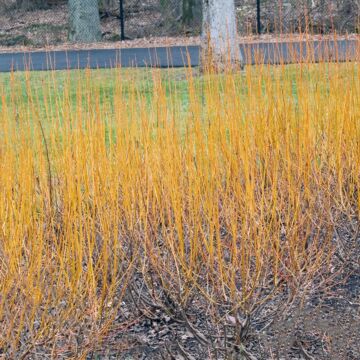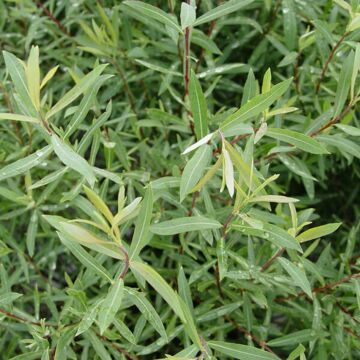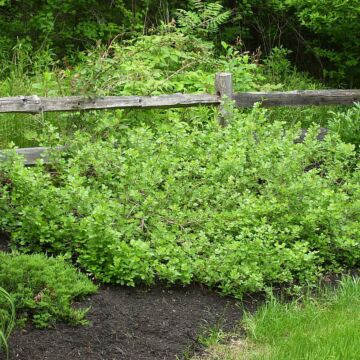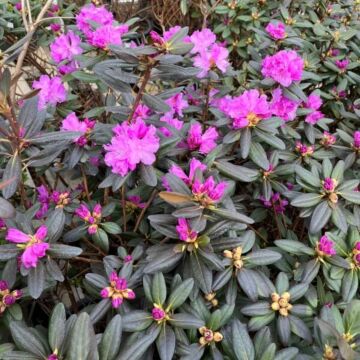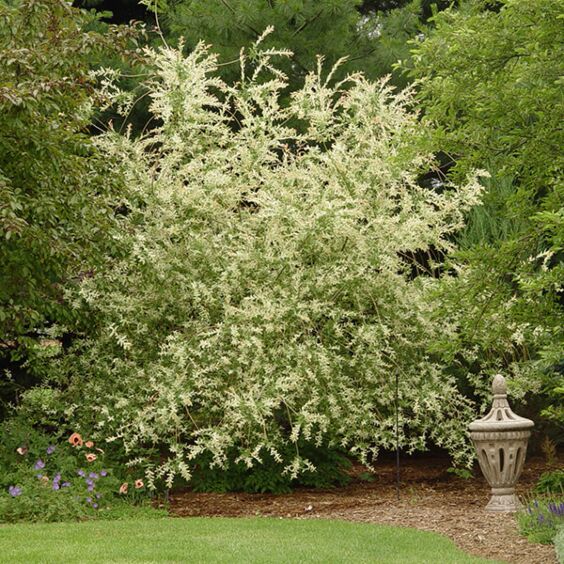
Growing zones
See Zone Map >Status: In stock
Please note: #5 containers cannot be shipped to Arizona, California, Idaho, Montana, Nevada, Oregon, Utah, Washington due to size restrictions.
- Sun, Part Sun/Shade
Mature Plant Size (H x W): 5-6' x 5-6'
Bloom Season: Spring
- Attracts Bees
- Attracts Birds
- Winter Interest
- Rain Gardens
- Walnut Toxicity Resistant
- Attracts Pollinators
Planting & Care for Dappled Willow Shrub
Preparation
- The Dappled Willow is a unique, tri-colored shrub exhibiting pink, light green, and white variegated foliage.
- Young stems have a bright pink color, turning red by winter.
- It’s an upright spreading shrub and reaches a mature height of about 5-6' tall.
- Do not have invasive root systems (but can be cut back to the ground each year to prevent damage).
- Will grow in moist soil and most wet growing conditions.
- Prefers partial shade.
- Cut back hard in early spring to force more colorful and healthy growth.
Opening Plant Material
- Bare Root: Cut open the bundle (top and roots are tied) and separate all the plants. Soak roots in buckets of water until planted. Each plant type will be labeled separately for identification. Keep the roots from full sun since they should never dry out. Keep roots covered. All bare-root plants must be trimmed when planted.
- B&B: Soak root ball well. Dig a hole at least 6" wider and no deeper than the size of the ball on the plant. Rotate the plant to the proper position. Never lift or move trees by the tops.
- Containers: Completely saturate all container plants by putting them in a larger water container until bubbling stops. Remove the plant, then dig a hole no deeper than the depth of the container, ensuring it’s wider on the sides by an additional 6” or more.
Planting Bare Root
- Plant bare root in fall. A good indicator of whether you can still plant is if the ground is still workable. If a hard frost is expected, hold off on planting.
- Dig a hole at least 6" wider and the same depth as the root mass. The crown or graft of the plant should be slightly higher than ground level where it was grown at the nursery.
- Trim off the broken roots and branches.
- Place fertilizer packets in the hole (if purchased). Do not place other fertilizers in the planting hole. *Use Our Recommended Fertilizer.
- Spread the roots and fill halfway with soil, then water until the soil settles completely, saturating the soil and planting pit.
- Re-adjust the plant and fill the hole with the rest of the soil.
- Backfill the balance of the soil and water well.
Planting B&B Trees
- Plant B&B trees in spring or fall. A good indicator of whether you can still plant is if the ground is still workable. If a hard frost is expected, hold off on planting.
- Notice where the base of the trunk flares out from the tree. This is called the root flare. This root flare should show when the tree is planted. Add soil under the ball so the root flare is exposed if necessary.
- Place fertilizer packets into the bottom of the hole (if purchased). *Use Our Recommended Fertilizer.
- Backfill ½ of the hole with soil and completely saturate the soil with water.
Once the tree is straight in the proper location, cut and remove twine. Then, remove or bend back the top of the metal basket. Lastly, remove the exposed burlap from the top of the ball. - Fill the hole to the top of the ball with soil, then soak well with water and let it settle.
- The top of the root ball should be visible and slightly higher than the soil around it.
Add mulch on top of the soil, making sure not to put mulch against the trunk or stems.
Planting Containers
- Dig a hole no deeper than the depth of the container and 6" or wider on the sides.
Slide the plant from the pot by tapping on the bottom of the pot. - With a shovel or knife, trim the bottom 2" off the root ball for plants in plastic containers.
- Rotate the plant to the proper position. Never lift or move plants by the tops.
Place the root ball in the hole. - Adjust the plant height so the root crown is slightly higher than the ground.
Notice where the base of the trunk flares out from the tree. This is called the root flare. This root flare should show when the tree is planted. Add soil under the ball so the root flare is exposed if necessary. - Place fertilizer packets into the bottom of the hole (if purchased). *Use Our Recommended Fertilizer.
- Backfill the hole with soil, ensuring the top of the root ball is visible and slightly higher than the soil around it.
- Firm the soil around the plant. Water well to settle soil around the root ball.
Pruning - After Planting
- Bare Root: Prune ALL bare root plants to reduce transplant shock and ensure successful planting. Pruning should occur as soon as possible, before or after planting, and with sharp pruning shears. Shrub pruning - thin shrub by removing large branches. Top back some branches to improve its general shape. Cut the shrub back to at least ½ its original size to promote new growth from the base.
- B&B, Grow Bags, and Containers: Although it’s not essential after planting, light pruning can help shape a Dappled Willow hedge. Doing so removes any broken branches from shipping or thins out a heavily branched plant to help in the transplanting process and the appearance of your new planting.
Pruning - Through-out the Season
- Renewal prune for best results. You can do this in spring or fall.
Watering - After Planting
- Plants typically take approximately 6 weeks to establish new roots in your soil. During this period, water plants as often as every 2-4 days at the start and at least a minimum of once per week.
- Beyond the 6-week establishment period, water once per week unless rain occurs.
- Remember to check soil moisture by sticking your finger into the soil around 3”.
Watering - Through-out the Season
- After the first season, plants should only be watered during extended periods without rain.
- How do you know if your plants need water? The easiest way to tell is to touch the soil around the roots. If it is moist, there is no need to water. If it’s dry, give it a good soak with the hose end (no nozzle), watering the soil only, not the leaves.
- Same as after planting, stick your finger into the soil around 3” to check soil moisture.
Frequently Asked Questions
How fast does a Dappled Willow grow?
Dappled Willow is known for its rapid growth rate, typically adding several feet to its height and spread each year. Under optimal conditions, it can grow up to 2 to 3 feet per year. To maintain its vigorous growth, ensure it has ample moisture, sunlight, and well-drained soil. Regular pruning can also help manage its size and encourage bushier growth.
How do I prune a Dappled Willow?
Pruning a Dappled Willow hedge is ideally performed in late winter or early spring, just before the onset of new growth. Begin by removing any dead, damaged, or overly thick branches to improve the plant's overall health and appearance. For a healthier and more attractive plant, thin out about one-third of the older branches annually, starting with the tallest and oldest. This thinning helps to encourage new growth and maintain the vibrant color of the younger stems.
Are Tri-Color Dappled Willows resistant to pests and diseases?
Tri-Colored Dappled Willows are relatively resistant to pests and diseases, making them a robust choice for many gardens. However, they can occasionally be affected by pests like aphids and issues like powdery mildew, especially when grown in less-than-ideal conditions. Ensuring good air circulation, proper watering, and regular maintenance can help keep these problems at bay.
How do I fertilize my Dappled Willow?
Fertilizing a Dappled Willow hedge requires using a balanced, slow-release fertilizer with a nutrient ratio of 10-10-10 for nitrogen, phosphorus, and potassium. This balanced approach promotes healthy and vigorous growth, enhancing the plant's striking foliage. It's best to apply the fertilizer every 4-6 weeks throughout the growing season, tapering off with a lighter application as the plant approaches dormancy. Always follow the recommended amounts on the fertilizer package to prevent overfeeding, which can weaken the plant and negatively impact the environment.
What companion plants pair well with a Tri-Colored Dappled Willow?
When pairing plants with a Tri-Colored Dappled Dappled Willow, consider those that thrive in similar moist and well-drained soil conditions. Good companions available from McKay Nursery include Astilbe, which adds textural contrast with its feathery blooms, and Hostas, whose broad leaves complement the fine foliage of the willow. Ferns can also be a beautiful addition, enhancing the woodland aesthetic and thriving in the same light conditions.
Upgrade Your Landscaping With McKay Nursery
At McKay Nursery, we pride ourselves on building up over a century of horticultural expertise by offering an exceptional selection of plants, including the captivating Dappled Willow. Based in Waterloo, Wisconsin, our nursery is dedicated to nurturing hardy, vibrant plants.
Order your Dappled Willow shrub from McKay Nursery, and you’ll receive top-quality plants, each supported by our one-year warranty. For more information, contact us at [email protected] or 920-478-2121.
Planting & Handling Help
Download our Planting and Handling Guide below to plan for a successful arrival and install of your plants. Be sure to water all plants as soon as they arrive and every day until you’re ready to plant. Keep any bare root bundles in a shady, cool spot with the roots covered at all times.


Learn More
Watch our videos on handling bare root plants, how your order is prepared for shipment and more.


Plant Sizing
What is the difference between Containers, Grow Bags, Bare Root, and Balled & Burlap (B&B)?
Shipping Times


Our FedEx and local shipping times depend on two factors, one is by the region and the second is the type of product being shipped. For example, small fruits are only shipped in spring, but majority of our perennials are shipped from spring until fall. Keep in mind the dates below act as a general guide. Due to unpredictable weather, staffing, inventory and industry demands these timelines can change. Therefore, we cannot guarantee any of these times.
Shipping Dates by Region*
Northern Cold Region: April 22nd - November 7th
Northern Region: April 15th - November 7th
Middle Region: April 1st - November 7th
Southern Region: March 15th - November 7th
Local Delivery (small radius from Waterloo, WI): April 22nd - November 7th
Shipping Dates by Season*
Spring Shipping: Region Start Date (above) - May
Fall Shipping: September - November
Due to unpredictable weather, these times may vary. Some varieties are exceptions due to heat and plant health reasons. Enter your shipping zip code at the top of this page and be sure to check the shipping information on each product before you add it to your cart. If the product is too large or restricted in your state, you will not be able to checkout with that item in your cart.

